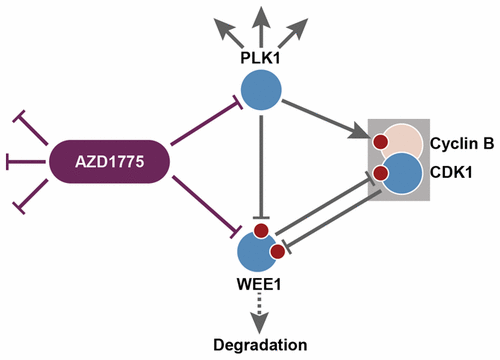当前位置:
X-MOL 学术
›
ACS Chem. Biol.
›
论文详情
Our official English website, www.x-mol.net, welcomes your
feedback! (Note: you will need to create a separate account there.)
Dual Targeting of WEE1 and PLK1 by AZD1775 Elicits Single Agent Cellular Anticancer Activity
ACS Chemical Biology ( IF 3.5 ) Pub Date : 2017-05-30 00:00:00 , DOI: 10.1021/acschembio.7b00147
Gabriela Wright 1 , Volha Golubeva 2 , Lily L. Remsing Rix 1 , Norbert Berndt 1 , Yunting Luo 3 , Grace A. Ward 1, 4 , Jhanelle E. Gray 5 , Ernst Schonbrunn 1, 3 , Harshani R. Lawrence 1, 3 , Alvaro N.A. Monteiro 2 , Uwe Rix 1
ACS Chemical Biology ( IF 3.5 ) Pub Date : 2017-05-30 00:00:00 , DOI: 10.1021/acschembio.7b00147
Gabriela Wright 1 , Volha Golubeva 2 , Lily L. Remsing Rix 1 , Norbert Berndt 1 , Yunting Luo 3 , Grace A. Ward 1, 4 , Jhanelle E. Gray 5 , Ernst Schonbrunn 1, 3 , Harshani R. Lawrence 1, 3 , Alvaro N.A. Monteiro 2 , Uwe Rix 1
Affiliation

|
Inhibition of the WEE1 tyrosine kinase enhances anticancer chemotherapy efficacy. Accordingly, the WEE1 inhibitor AZD1775 (previously MK-1775) is currently under evaluation in clinical trials for cancer in combination with chemotherapy. AZD1775 has been reported to display high selectivity and is therefore used in many studies as a probe to interrogate WEE1 biology. However, AZD1775 also exhibits anticancer activity as a single agent although the underlying mechanism is not fully understood. Using a chemical proteomics approach, we here describe a proteome-wide survey of AZD1775 targets in lung cancer cells and identify several previously unknown targets in addition to WEE1. In particular, we observed polo-like kinase 1 (PLK1) as a new target of AZD1775. Importantly, in vitro kinase assays showed PLK1 and WEE1 to be inhibited by AZD1775 with similar potency. Subsequent loss-of-function experiments using RNAi for WEE1 and PLK1 suggested that targeting PLK1 enhances the pro-apoptotic and antiproliferative effects observed with WEE1 knockdown. Combination of RNAi with AZD1775 treatment suggested WEE1 and PLK1 to be the most relevant targets for mediating AZD1775’s anticancer effects. Furthermore, disruption of WEE1 by CRISPR-Cas9 sensitized H322 lung cancer cells to AZD1775 to a similar extent as the potent PLK1 inhibitor BI-2536 suggesting a complex crosstalk between PLK1 and WEE1. In summary, we show that AZD1775 is a potent dual WEE1 and PLK1 inhibitor, which limits its use as a specific molecular probe for WEE1. However, PLK1 inhibition makes important contributions to the single agent mechanism of action of AZD1775 and enhances its anticancer effects.
中文翻译:

AZD1775对WEE1和PLK1的双重靶向引发单药细胞抗癌活性
WEE1酪氨酸激酶的抑制作用增强了抗癌化学疗法的功效。因此,WEE1抑制剂AZD1775(以前为MK-1775)目前正在临床试验中进行化学疗法联合治疗。据报道,AZD1775具有很高的选择性,因此在许多研究中都被用作质询WEE1生物学的探针。然而,AZD1775也显示出作为单一药物的抗癌活性,尽管其潜在机理尚不完全清楚。使用化学蛋白质组学方法,我们在这里描述了肺癌细胞中AZD1775靶标的全蛋白组范围调查,并确定了除WEE1之外的几个以前未知的靶标。特别是,我们观察到polo样激酶1(PLK1)作为AZD1775的新靶标。重要的是,体外激酶测定表明PLK1和WEE1被AZD1775抑制的效价相似。随后使用RNAi对WEE1和PLK1进行功能丧失的实验表明,靶向PLK1可增强WEE1敲低观察到的促凋亡和抗增殖作用。RNAi与AZD1775处理的结合表明WEE1和PLK1是介导AZD1775抗癌作用的最相关靶标。此外,WEE1的中断CRISPR-Cas9的研究表明H322肺癌细胞对AZD1775的敏感性与有效的PLK1抑制剂BI-2536相似,表明PLK1和WEE1之间存在复杂的串扰。总之,我们显示AZD1775是有效的WEE1和PLK1双重抑制剂,这限制了它作为WEE1的特异性分子探针的用途。但是,PLK1抑制对AZD1775的单药作用机制做出了重要贡献,并增强了其抗癌作用。
更新日期:2017-06-28
中文翻译:

AZD1775对WEE1和PLK1的双重靶向引发单药细胞抗癌活性
WEE1酪氨酸激酶的抑制作用增强了抗癌化学疗法的功效。因此,WEE1抑制剂AZD1775(以前为MK-1775)目前正在临床试验中进行化学疗法联合治疗。据报道,AZD1775具有很高的选择性,因此在许多研究中都被用作质询WEE1生物学的探针。然而,AZD1775也显示出作为单一药物的抗癌活性,尽管其潜在机理尚不完全清楚。使用化学蛋白质组学方法,我们在这里描述了肺癌细胞中AZD1775靶标的全蛋白组范围调查,并确定了除WEE1之外的几个以前未知的靶标。特别是,我们观察到polo样激酶1(PLK1)作为AZD1775的新靶标。重要的是,体外激酶测定表明PLK1和WEE1被AZD1775抑制的效价相似。随后使用RNAi对WEE1和PLK1进行功能丧失的实验表明,靶向PLK1可增强WEE1敲低观察到的促凋亡和抗增殖作用。RNAi与AZD1775处理的结合表明WEE1和PLK1是介导AZD1775抗癌作用的最相关靶标。此外,WEE1的中断CRISPR-Cas9的研究表明H322肺癌细胞对AZD1775的敏感性与有效的PLK1抑制剂BI-2536相似,表明PLK1和WEE1之间存在复杂的串扰。总之,我们显示AZD1775是有效的WEE1和PLK1双重抑制剂,这限制了它作为WEE1的特异性分子探针的用途。但是,PLK1抑制对AZD1775的单药作用机制做出了重要贡献,并增强了其抗癌作用。

































 京公网安备 11010802027423号
京公网安备 11010802027423号